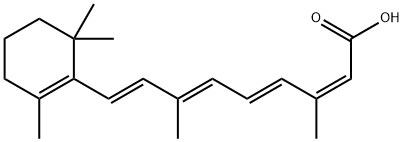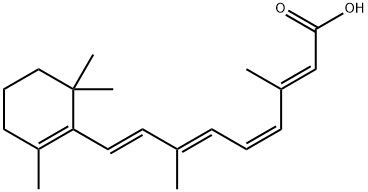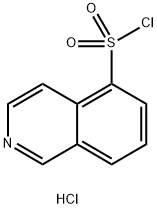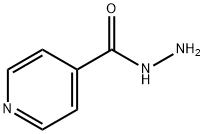Isotretinoin , ≥98% , 4759-48-2
Synonym(s):
13-cis-Retinoic acid;Isotretinoin
CAS NO.:4759-48-2
Empirical Formula: C20H28O2
Molecular Weight: 300.44
MDL number: MFCD00079542
EINECS: 225-296-0
| Pack Size | Price | Stock | Quantity |
| 100MG | RMB30.40 | In Stock |
|
| 500MG | RMB87.20 | In Stock |
|
| 1g | RMB89.60 | In Stock |
|
| 5g | RMB324.00 | In Stock |
|
| 25g | RMB964.00 | In Stock |
|
| 100g | RMB1371.20 | In Stock |
|
| others | Enquire |
PRODUCT Properties
| Melting point: | 172-175 °C (lit.) |
| Boiling point: | 381.66°C (rough estimate) |
| Density | 1.0597 (rough estimate) |
| refractive index | 1.4800 (estimate) |
| storage temp. | -20°C |
| solubility | Practically insoluble in water, soluble in methylene chloride, slightly soluble in ethanol (96 per cent). It is sensitive to air, heat and light, especially in solution. Carry out all operations as rapidly as possible and avoid exposure to actinic light; use freshly prepared solutions. |
| form | Fine Crystalline Powder |
| pka | 4.76±0.33(Predicted) |
| color | Yellow-orange to orange |
| biological source | synthetic |
| Water Solubility | insoluble |
| λmax | 354nm(EtOH)(lit.) |
| Merck | 14,5228 |
| Stability: | Stable, but probably air and light sensitive. Combustible. Incompatible with strong oxidizing agents. |
| InChIKey | SHGAZHPCJJPHSC-YCNIQYBTSA-N |
| CAS DataBase Reference | 4759-48-2(CAS DataBase Reference) |
| EPA Substance Registry System | Isotretinoin (4759-48-2) |
Description and Uses
Isotretinoin is the 9-cis isomer of retinoic acid, a close relative of retinol, or vitamin A. It was originally developed to treat cystic acne, and today this is still its primary use despite several more modern applications of the drug, including a treatment for pancreatic and brain cancers. First shown to be an effective treatment for acne in 1982, its development stemmed from advances in knowledge of the effects of vitamin A to reduce or eliminate sebum production. Since that time, however, several instances of deleterious effects became well known, most notably birth defects arising from the use of isotretinoin.
isotretinoin is a retinoid derivative with improved bioavailability and percutaneous absorption for acne treatment products. Presently being studied in conjuction with the treatment of photoaged skin.
Safety
| Symbol(GHS) |   GHS07,GHS08 |
| Signal word | Danger |
| Hazard statements | H315-H319-H335-H360 |
| Precautionary statements | P201-P302+P352-P305+P351+P338-P308+P313 |
| Hazard Codes | T |
| Risk Statements | 61-36/37/38-20/21/22 |
| Safety Statements | 53-26-36/37/39-45-37/39 |
| WGK Germany | 3 |
| RTECS | VH6440000 |
| TSCA | Yes |
| HS Code | 29362100 |
| Hazardous Substances Data | 4759-48-2(Hazardous Substances Data) |
| Toxicity | LD50 (20 day) in mice, rats (mg/kg): 904, 901 i.p.; 3389, >4000 orally (Kamm) |






